Businesses need email tools for better marketing. These tools send emails automatically and keep track of them. A good email tool helps your marketing do well. You must pick a tool that fits your business to be effective.
Mailshake is a favorite choice. Mailshake is easy to use and has many features. Yet, it is useful to look at other options that may work better for you. With new digital marketing tools coming out, some may have better features or prices for your goals.
Criteria for evaluating Mailshake alternatives
It is important to understand what you are selecting and what features you will get. When picking an email tool, think about these things:
- Easy to Use: The tool should be simple so everyone can use it without a lot of training.
- Features and Integrations: The tool should have what you need and work with the software you already use.
- Pricing: The tool should be a good deal and not have extra costs.
- Customer Support: Good support can help solve problems quickly.
- Scalability: The tool should be able to handle more work if your business grows.
- Automation and Personalization: These features can make your marketing better.
Selecting the right tool is the most important stage of buying their paid subscription. It is recommended that users read the company’s terms and conditions thoroughly before making a purchase.
1. SalesLoft
SalesLoft is a good Mailshake replacement with many sales tools. Mailshake mainly does email campaigns, but SalesLoft does more. It uses different channels and advanced analytics. This is good for businesses that need a strong and flexible platform for sales.
It is for big companies with sales teams. They like it because it has many advanced options and can be customized. It helps with all sales steps, from finding customers to making deals. The workflows can change. This helps users work better and smarter.
But this tool costs a lot. It has many features but may be too expensive for small companies or new ones with small budgets. Even so, SalesLoft has different prices for different needs. You must ask their sales team how much it costs. The prices are high because of the good features and how well it works with other systems. It is a high cost for companies that want to do better in sales.
2. Outreach.io
Outreach.io is also for selling, and it is automatic and makes sales better. It is another choice instead of Mailshake. It has more advanced options and can grow. Big companies with lots of sales work like it. Outreach.io works with many CRM systems and sales tools. This makes it flexible for making sales work smoother.
The platform has many options that help salespeople work better and faster. Key capabilities are catching customers through many channels like email, phone, and social media. Sales teams get reports and analyses to see how well campaigns and sales actions are performing. Automation makes sure people do not forget to follow up. AI helps to make sales outreach better. The system works with big CRM platforms for easier use and better sales processes.
They have many tools for the whole sales process, from finding to closing deals. It saves time and cuts down on work, so salespeople can do more important things. But, learning to use all its jobs can be hard. It also might cost too much for small companies or those without much money.
Their prices fit different sized companies, and people need to ask their sales team for a price. The prices show it is for those who want to spend on a strong sales tool.
3. Yesware
Yesware is a strong sales tool that works with Gmail and Outlook. It is good for companies that want to focus on emails to sell things. Yesware helps sales teams do better with tools for simple email tracking, automatic follow-ups, and checking performance. It is easy to use and has many features. This is good for small to medium companies that want to manage selling talks well.
The best thing is that it can track emails well. This lets users see how people interact, like when they open emails and click on links. This feature gives us very useful information about how interested people are. It helps sales teams make and adjust their plans for reaching out to people much better. Yesware also makes it easy to work with CRM systems like Salesforce. It allows for easy sharing of data and better views of sales activities inside the CRM.
The platform works well with Gmail and Outlook. It is easy to use because it uses email systems people know. This makes it easy for users to learn and get the most out of it. Yesware gives companies good data they can use to make their sales tactics better and do better overall. However, Yesware mainly uses email to communicate with people. This might not be good for companies that need to talk to people in many different ways. Also, even though Yesware has good reporting tools, they might not be as deep as what other more advanced sales platforms offer.
They have different prices to fit different company needs and money situations. They have basic features in the simple plan and more complete options in the higher plans. Companies can choose what they need and can change as they grow over time.
4. Lemlist
Lemlist is a different sales platform that is a good option compared to Mailshake. It focuses on custom emails for sales teams and marketers. Lemlist helps companies make very custom email campaigns that really talk to the people they want to reach. It is good at making emails personal and automatic. This helps to get people more involved and more likely to do something. It is popular for both new companies and big businesses.
Its special thing is that it can make custom email campaigns automatic. Users can add their own pictures and words to make each message feel special to the person getting it. The platform gives powerful tracking tools. Users can watch key numbers like open rates and click-through rates. It works with top CRM systems like Salesforce and HubSpot. This makes it efficient by keeping contacts and interactions the same across different platforms. Lemlist helps with many ways of reaching out, such as email, LinkedIn, and calls. This gives different ways to engage.
The tool helps make things more personal. This really helps with getting users involved and making more sales. Its easy-to-use design and automated features make it simple for people who are not very technical. But, starting out and using the advanced stuff can be hard for some. Lemlist works well with CRMs, but it might not have as good analytics and reports as other big sales tools.
The company offers pricing that can change for what a company needs. The simple plan is for small teams and has the basic stuff. Plans with more features have things like ways to reach out over many channels and tools for teams to work together. Companies can start with a small plan and go up to a bigger one as they grow and need more.
5. GMass
GMass is a strong tool for email marketing and works well with Gmail. Small businesses, marketers, and sales teams like it for its easy use and Gmail’s functions.
Some main things GMass does include sending a lot of emails from Gmail. It uses templates for emails that you can change. GMass gets users more involved with detailed tracking of open rates, click-through rates, and answers. It has automated emails that keep going to leads based on what they do. The platform’s scheduling lets users send emails at the best times. This improves how often people respond and engage.
The tool is good because it works well with Gmail. This makes it easy to learn, and you do not need extra software. It has easy mail merge and automation for people who like simple email marketing. But GMass depends on Gmail too much. This is hard for users who need to work with different email clients. GMass has good basic tools, but it might not have some special customization and reports that other email marketing services have.
The tools are available at different prices for different user needs. The basic plan is cheap, which is good for small businesses and single users. More expensive plans have more tools like better analytics and faster customer help, and you can send more emails. This means users can pick a price that fits their needs and how much they can pay. They can move up to better plans as their email marketing grows.
Conclusion
Looking at other options for Mailshake in 2024 shows many products for sales and marketing. All of these alternatives are good in their own ways. They have things like full outreach for many channels and good automation synchronize well, and they work easily with CRM systems. It is important to choose a service that fits what your organization needs and how it wants to grow.
Moving ahead, sales engagement tools keep changing with new automation driven by AI, better ways to make emails personal, and deeper looks into data. Companies will do better in email advertising if they know about these new changes and technologies.
Using these new things makes work better and helps with customers. It makes the business grow in a hard market. Companies try to better their contact with people and get more active. They look for the best Mailshake different thing. It is for good plans and being ready for the future online.

